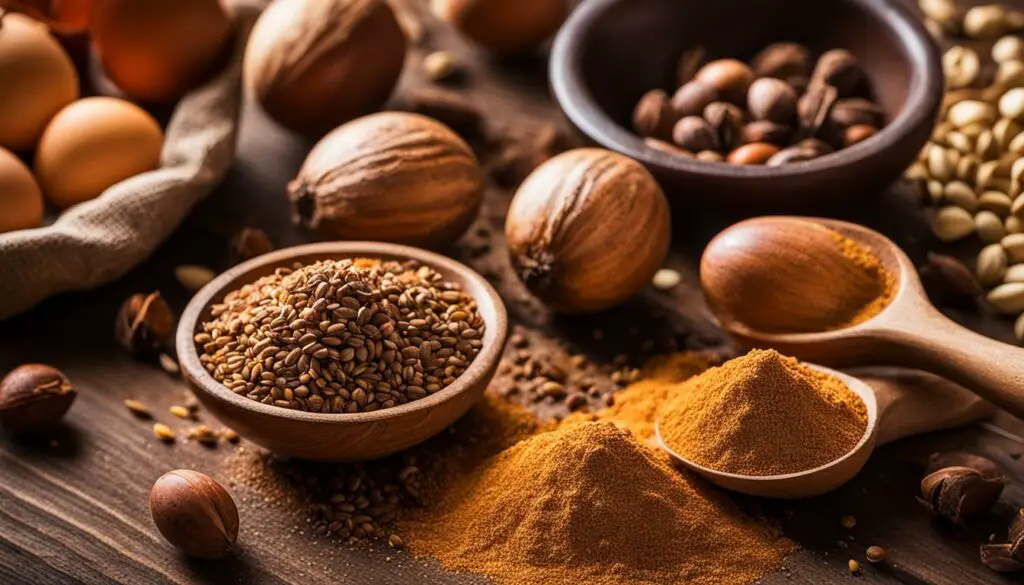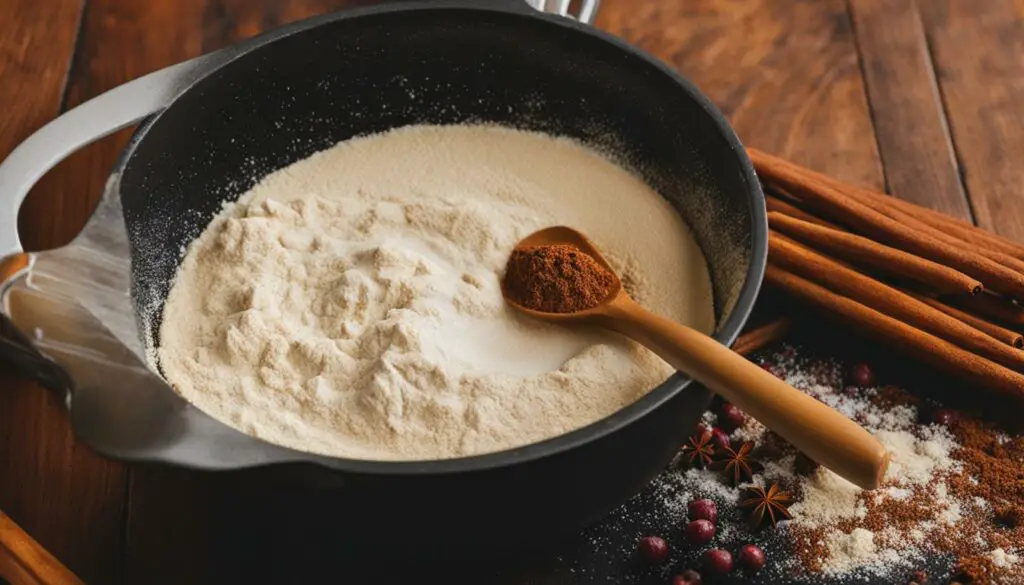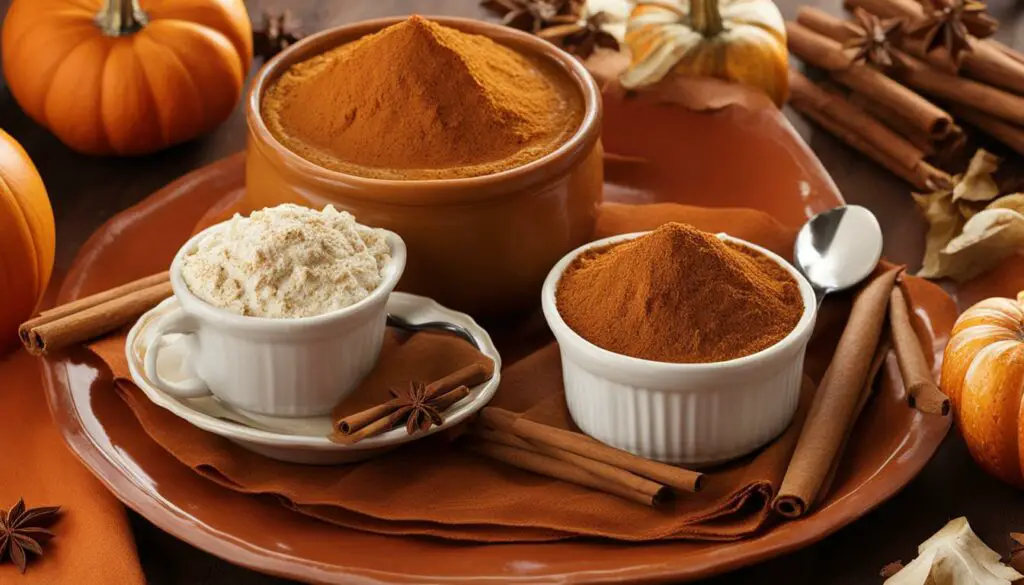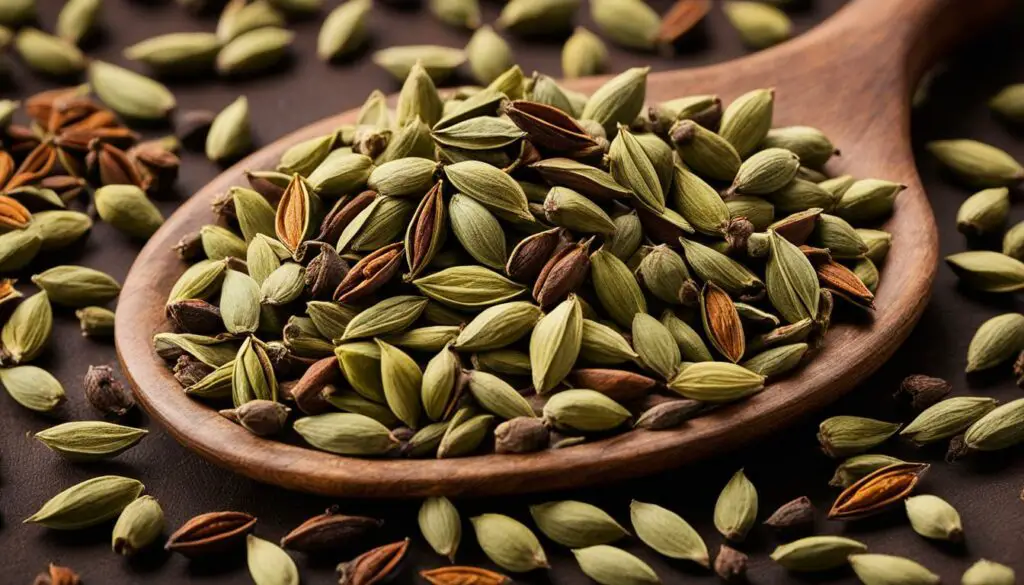Are you searching for cinnamon substitutes for your baking recipes? Look no further. In this article, we will explore the best alternatives to cinnamon for baking, so you can create delicious treats without sacrificing flavor.
Table of Contents
Key Takeaways:
- There are several options available as cinnamon substitutes for baking recipes.
- Each alternative has its own unique flavor and can add depth to your baked goods.
- Nutmeg, allspice, ginger, pumpkin pie spice, cardamom, cloves, and mace are popular substitutes for cinnamon.
- Experimenting with these substitutes can lead to exciting new flavors in your baking creations.
- Don’t worry if you run out of ground cinnamon – you can make your own using cinnamon sticks.
Types of Cinnamon and Their Flavors
When it comes to cinnamon, there are different types that offer unique flavors. Understanding the characteristics of each type can help you choose the perfect substitute for your baking needs.
Ceylon Cinnamon
Ceylon cinnamon, often referred to as “true” cinnamon, is known for its delicate and complex flavor. It has floral and citrus notes that add a subtle sweetness to your recipes. Ceylon cinnamon is perfect for desserts, beverages, and sweet dishes where you want the cinnamon flavor to shine without overpowering other ingredients.
Saigon Cinnamon
Saigon cinnamon, also known as Vietnamese cinnamon, is prized for its intense heat and bold sweetness. It has a rich, spicy flavor that is perfect for adding depth to dishes. Saigon cinnamon works well in savory recipes, as well as in baked goods where you want a strong and aromatic cinnamon flavor.
Korintje Cinnamon
Korintje cinnamon, originating from Indonesia, has a bittersweet flavor profile with hints of cloves and nutmeg. It adds a warm and comforting taste to your recipes. Korintje cinnamon is versatile and can be used in both sweet and savory dishes, making it a great all-around substitute for baking.
Now that you know about the different types of cinnamon and their flavors, you can choose the perfect substitute for your favorite recipes. Whether you prefer the delicate notes of Ceylon cinnamon, the boldness of Saigon cinnamon, or the bittersweet taste of Korintje cinnamon, each type offers its own unique experience.
Nutmeg as a Cinnamon Substitute

Nutmeg is a versatile spice that can be used as a substitute for cinnamon in baking. It has a warming, slightly nutty flavor that pairs well with sweet recipes. Nutmeg is often combined with cinnamon in dishes like pumpkin pie, where it adds depth and complexity to the flavor profile.
Unlike cinnamon, nutmeg has a distinct flavor that is less sweet and more savory. Its earthy, aromatic notes can enhance the taste of cookies, cakes, and breads.
If you’re looking to experiment with nutmeg as a cinnamon substitute, here are some popular recipes where it can be used:
- Apple pie – Sprinkle a pinch of nutmeg along with cinnamon over the apple filling to enhance the flavors.
- Snickerdoodle cookies – Replace the cinnamon in the recipe with an equal amount of nutmeg and enjoy a unique twist on this classic cookie.
- Spiced muffins – Combine nutmeg with other warm spices like ginger and cloves to create deliciously spiced muffins.
Additionally, nutmeg can be used as a standalone spice in certain recipes that call for its distinct flavor. Its versatility makes it a great option for bakers looking to experiment with different tastes and create unique desserts.
Benefits of Using Nutmeg
In addition to its flavor, nutmeg also offers several health benefits. It contains essential nutrients like manganese, copper, and magnesium, which are important for maintaining overall health. Nutmeg also has antioxidant properties and may have anti-inflammatory effects.
However, it’s important to note that nutmeg should be used in moderation, as consuming large amounts can have adverse effects. Stick to the recommended measurements in your recipes to ensure a balanced flavor and experience the benefits without any risks.
The Difference Between Nutmeg and Cinnamon
While nutmeg can be a great substitute for cinnamon in certain recipes, it’s important to understand the differences between the two spices. Here’s a comparison of nutmeg and cinnamon:
| Nutmeg | Cinnamon |
|---|---|
| Has a warming, slightly nutty flavor | Has a sweet and warm flavor |
| Comes from the seed of the nutmeg tree | Comes from the bark of cinnamon trees |
| Offers a more savory taste | Offers a more sweet taste |
| Pairs well with other warm spices like cloves and ginger | Complements a wide range of flavors |
As with any substitution, the flavor profile may vary slightly, but nutmeg can still provide an enjoyable alternative to cinnamon in your baking endeavors.
Allspice as a Cinnamon Substitute

Allspice is a versatile spice with a distinct flavor that can easily replace cinnamon in your baking recipes. Its unique taste combines the flavors of cinnamon, cloves, nutmeg, and black pepper, creating a warm and complex profile that adds depth to your baked goods.
Whether you’re making cookies, cakes, or bread, allspice can enhance the flavor of your favorite recipes. Its rich and aromatic notes make it a great choice for both sweet and savory dishes, allowing you to experiment and create delicious culinary creations.
Using allspice in baking is simple. Just replace the amount of cinnamon called for in your recipe with an equal amount or adjust to taste. Keep in mind that allspice has a slightly stronger flavor than cinnamon, so you may want to start with a smaller amount and gradually increase it if desired.
Allspice is also a key ingredient in popular spice blends like pumpkin pie spice, which is commonly used in seasonal desserts. Its warm and spicy character complements the flavors of other spices, making it a versatile choice for various recipes.
Try using allspice in your next batch of cookies or bread, and experience the unique and inviting flavor it brings to your baked treats.
Benefits of Using Allspice in Baking:
- Provides a warm and complex flavor profile
- Can be used in sweet and savory recipes
- Enhances the taste of your baked goods
- Offers a unique substitute for cinnamon
| Allspice Flavor Profile | Sweetness | Spiciness | Warmth |
|---|---|---|---|
| Medium | 🌟🌟🌟 | 🌟🌟🌟 | 🌟🌟🌟🌟 |
Ginger as a Cinnamon Substitute

Ginger is a versatile spice that can be used as a substitute for cinnamon in baking. Its warm and sweet flavor adds a unique twist to your recipes and is a great alternative to cinnamon in certain dishes. Whether you’re making cookies, cakes, or bread, ginger can elevate the flavor profile of your baked goods.
In addition to its distinct taste, ginger offers a range of health benefits. It is known for its anti-inflammatory and digestive properties, making it an excellent choice for incorporating into your baking recipes. Ginger can also provide a refreshing and zesty flavor that complements both sweet and savory dishes.
When using ginger as a cinnamon substitute, it’s essential to consider the amount and intensity of its flavor. Ginger has a more pronounced and pungent taste compared to cinnamon, so you may need to adjust the quantity according to your preferences. It’s recommended to start with a smaller amount and gradually increase to achieve the desired ginger flavor.
“Ginger has a unique flavor that can add depth and complexity to your baked goods, making it an excellent alternative to cinnamon in certain recipes.”
Using Ginger in Baking
Here are some creative ways to incorporate ginger into your baking:
- Grated Ginger: Add freshly grated ginger to your cookie or cake batter for a burst of ginger flavor.
- Ginger Powder: Substitute cinnamon with ginger powder in recipes like gingerbread or spice cakes for a warm and aromatic taste.
- Gingerbread Cookies: Make traditional gingerbread cookies with a ginger-focused flavor profile by increasing the amount of ginger and reducing the cinnamon.
- Ginger Snaps: Swap out cinnamon for ginger in your favorite ginger snap cookie recipe for a spicier and more robust flavor.
Remember to get creative in the kitchen and experiment with different combinations of spices to find the perfect balance of flavors. Ginger can bring an exciting twist to your baking creations and provide a delightful sensory experience.
To get a visual idea of how ginger can substitute cinnamon in baking, take a look at the table below:
| Ginger | Cinnamon |
|---|---|
| Warm and sweet flavor | Warm and slightly sweet flavor |
| Pronounced and pungent taste | Milder flavor with hints of sweetness and warmth |
| Commonly used in Asian and Indian cuisines | Commonly used in Western cuisines and desserts |
As you can see from the table, ginger offers a distinct and bold flavor compared to cinnamon. Substituting ginger for cinnamon can bring a new and exciting dimension to your baked goods.
Pumpkin Pie Spice as a Cinnamon Substitute

Pumpkin pie spice is a versatile blend of spices that can serve as an excellent substitute for cinnamon in your baking endeavors. This aromatic spice mixture typically consists of cinnamon, nutmeg, ginger, and cloves. Not only is it commonly used in pumpkin pie recipes, but it can also be incorporated into a wide range of other baking recipes to add depth and richness to your creations.
The combination of flavors found in pumpkin pie spice provides a delightful twist to your baked goods, giving them a warm and comforting taste. The aromatic notes of cinnamon, the earthy sweetness of nutmeg, the subtle heat of ginger, and the pungent warmth of cloves all come together to create a flavorful experience that will leave your taste buds craving for more.
Pumpkin pie spice can be used in various recipes where cinnamon is traditionally called for. It pairs exceptionally well with baked goods such as cakes, cookies, muffins, and bread. You can sprinkle it over the top of your treats, mix it into the batter, or incorporate it into a delicious spiced glaze to enhance the flavor profile of your baked goods.
If you’re looking to experiment with different flavors and create unique combinations, pumpkin pie spice can be a great spice blend to have on hand in your kitchen. Its warm and inviting aroma is sure to impress your guests and bring a touch of autumnal charm to any dessert you make.
Benefits of Using Pumpkin Pie Spice in Baking
Using pumpkin pie spice in your baking offers several benefits. Firstly, it adds complexity and depth to the flavor profile of your desserts, making them more interesting and enjoyable to eat. The combination of spices in pumpkin pie spice can also help balance the sweetness in your baked goods, preventing them from becoming overly sugary.
Furthermore, pumpkin pie spice can save you time and effort in the kitchen. Since it is a pre-mixed blend of spices, you don’t have to measure and combine individual spices each time you bake. Having a jar of pumpkin pie spice readily available allows you to streamline your baking process and focus on creating delicious treats.
Lastly, using pumpkin pie spice in your baking allows you to explore new flavor combinations and expand your culinary repertoire. By substituting cinnamon with pumpkin pie spice, you can create desserts that are unique and unexpected, adding a delightful twist to familiar recipes.
| Spice | Flavor Profile |
|---|---|
| Cinnamon | Warm and slightly sweet |
| Nutmeg | Earthy and subtly sweet |
| Ginger | Spicy and slightly citrusy |
| Cloves | Strong and pungent |
“Using pumpkin pie spice in my baking has been a game-changer. It adds a depth of flavor that elevates my desserts and keeps my guests asking for more. I love the combination of spices and the warm aroma it brings to my kitchen.”
– Jane, baking enthusiast
Cardamom as a Cinnamon Substitute

When it comes to baking, cardamom is a versatile spice that can add a delightful twist to your recipes. With its fragrant aroma and sweet yet spicy flavor, cardamom can be an excellent substitute for cinnamon. Not only does it provide a unique flavor profile, but it also enhances the taste of your baked goods.
Cardamom is commonly used in both sweet and savory dishes, making it a popular choice among chefs and home cooks alike. Its distinct flavor adds depth and complexity to a wide range of recipes, including cookies, cakes, bread, and pastry.
“Cardamom adds a delightful fragrance and warmth to my cinnamon-free apple pie. It gives the dessert a unique flavor that always keeps my guests wanting more.”
When using cardamom as a substitute for cinnamon in baking, it’s important to keep in mind that the two spices have different flavor profiles. While cinnamon is known for its warm and slightly spicy taste, cardamom offers a sweet and spicy flavor with hints of citrus and floral notes.
Using Cardamom in Baking
Cardamom can be used in both powdered and whole form, depending on your preference and the recipe requirements. Ground cardamom is convenient to use and can be easily added to your batters and doughs. Whole cardamom pods can be crushed or ground to release their aromatic oils, providing a more intense flavor.
If you’re experimenting with cardamom in baking, start by adding small amounts to your recipes and adjust to taste. It’s always best to start with a conservative amount and gradually increase it, as cardamom can have a strong flavor that may overpower other ingredients.
Cardamom pairs well with a variety of ingredients, including citrus fruits, chocolate, nuts, and warm spices like ginger and nutmeg. You can use it as a standalone substitute for cinnamon or combine it with other spices to create a unique flavor profile for your baked goods.
Whether you’re making cookies, muffins, or a classic coffee cake, adding cardamom to your recipes can take your baking to the next level. Its distinctive flavor and aroma will surely impress your family and friends.
| Benefits of Using Cardamom in Baking | How to Use Cardamom in Baking |
|---|---|
|
|
Cloves as a Cinnamon Substitute

Cloves are a versatile spice that can be used as a substitute for cinnamon in baking. With their strong, slightly bitter taste, cloves add a unique flavor and depth to your baked goods. They pair especially well with other spices like ginger and nutmeg, creating a delightful combination of flavors.
When using cloves as a cinnamon substitute, it’s important to understand their flavor profile and how to incorporate them effectively into your recipes. Cloves have a distinct taste that is often described as warm, aromatic, and slightly sweet. They can be overpowering if used in excess, so it’s best to use them sparingly and balance their flavor with other ingredients.
One popular way to use cloves in baking is in combination with other spices. For example, you can create a warm and comforting spice blend by combining cloves, cinnamon, nutmeg, and ginger. This blend can be used in various recipes like apple pie, gingerbread cookies, or spiced muffins.
“Cloves have a distinct taste that is often described as warm, aromatic, and slightly sweet.”
In addition to their flavor, cloves also offer other benefits in baking. They have natural antibacterial properties and can help preserve the freshness of baked goods. Cloves are also rich in antioxidants and have been used in traditional medicine for their potential health benefits.
Here’s a simple recipe that showcases cloves as a cinnamon substitute:
Spiced Pear Muffins:
- Ingredients:
- 2 cups all-purpose flour
- 1/2 cup granulated sugar
- 1 tablespoon baking powder
- 1/2 teaspoon salt
- 1/2 teaspoon ground cloves
- 1/2 teaspoon ground nutmeg
- 1/2 cup unsalted butter, melted
- 1 cup milk
- 1 large egg
- 1 teaspoon vanilla extract
- 2 ripe pears, peeled, cored, and diced
- Preheat the oven to 375°F (190°C) and line a muffin tin with paper liners.
- In a large bowl, whisk together the flour, sugar, baking powder, salt, ground cloves, and ground nutmeg.
- In a separate bowl, whisk together the melted butter, milk, egg, and vanilla extract. Pour the wet ingredients into the dry ingredients and stir until just combined.
- Gently fold in the diced pears.
- Spoon the batter into the prepared muffin tin, filling each cup about two-thirds full.
- Bake for 18-20 minutes or until a toothpick inserted into the center of a muffin comes out clean.
- Remove from the oven and let the muffins cool in the tin for a few minutes before transferring them to a wire rack to cool completely.
These spiced pear muffins are a delicious example of how cloves can be used as a cinnamon substitute in baking. The ground cloves add a rich and aromatic flavor to the muffins, complementing the sweetness of the pears and the warmth of the other spices.
Incorporating cloves into your baking repertoire allows you to explore new flavors and expand your culinary creativity. Whether you’re making pies, cookies, or muffins, the distinct flavor of cloves can elevate your baked goods and provide a delightful alternative to cinnamon.
Mace as a Cinnamon Substitute

If you’re looking for an alternative to cinnamon in your baking, consider using mace. Mace is a spice that comes from the same fruit as nutmeg, so it offers a similar flavor profile. However, mace has a slightly sweeter and less intense flavor compared to cinnamon, making it a unique substitute that can add a new dimension to your recipes.
When using mace as a cinnamon substitute, keep in mind that its flavor can be quite potent, so it’s important to use it sparingly. Start by using small amounts and adjust according to your taste preferences. Mace pairs well with a variety of flavors, especially in sweet dishes like cakes, cookies, and pastries.
One popular way to use mace in baking is to combine it with other spices like nutmeg and ginger to create a warm and aromatic flavor profile. This combination works particularly well in pumpkin-based desserts like pies and breads.
To highlight the unique flavor of mace in your baking, consider using it as a featured ingredient in a recipe. Try adding a pinch of ground mace to your favorite sugar cookie dough or sprinkle it over a freshly baked cinnamon roll for an unexpected twist on a classic treat.
With its distinct flavor and versatility, mace can be a great alternative to cinnamon in your baking endeavors. Experiment with mace in your recipes to discover new and exciting flavor combinations that will delight your taste buds and impress your friends and family.
Cinnamon Stick as a Substitute for Ground Cinnamon
If you don’t have ground cinnamon on hand, don’t worry! You can use a cinnamon stick as a substitute and easily make your own ground cinnamon from scratch.
Here’s how you can do it:
- Take a cinnamon stick and break it into smaller pieces.
- Place the broken cinnamon stick pieces into a clean coffee grinder or blender.
- Pulse or grind the cinnamon stick until it reaches a fine consistency, similar to ground cinnamon.
- Store the freshly ground cinnamon in an airtight container.
Now you have your very own ground cinnamon made from cinnamon sticks! It’s a convenient option if you run out of ground cinnamon and need it for your baking recipes.
Remember, 1 cinnamon stick is equivalent to approximately 1 teaspoon of ground cinnamon. Adjust the amount based on your recipe’s requirements.
Not only does using cinnamon sticks provide you with a ground cinnamon substitute, but it also allows you to experience the rich flavor and aroma of freshly ground cinnamon, enhancing the taste of your baked goods.
Conclusion
In conclusion, if you’re looking for alternatives to cinnamon for baking, there are plenty of options to choose from. Nutmeg, allspice, ginger, pumpkin pie spice, cardamom, cloves, and mace can all be used as substitutes for cinnamon in different recipes. Each of these spices offers its own unique flavor profile, allowing you to add depth and complexity to your baked goods.
Whether you’re in need of a warm and nutty flavor, a spicy and sweet kick, or a combination of aromatic spices, these cinnamon substitutes have got you covered. Don’t be afraid to experiment with these alternatives to discover new and exciting flavors in your baking creations.
So, the next time you run out of cinnamon or are simply looking to try something different, reach for one of these substitutes. With their versatility and delicious taste, you’ll be able to enjoy a world of flavors and elevate your baking game to a whole new level.
FAQ
What are some alternatives to cinnamon for baking?
Some alternatives to cinnamon for baking include nutmeg, allspice, ginger, pumpkin pie spice, cardamom, cloves, and mace.
What flavors do different types of cinnamon have?
Ceylon cinnamon has floral and citrus notes, Saigon cinnamon is hotter and sweeter, and Korintje cinnamon has a bittersweet flavor.
Can I use nutmeg as a substitute for cinnamon in baking?
Yes, nutmeg can be used as a substitute for cinnamon in baking. It has a warming, slightly nutty flavor that pairs well with sweet recipes.
How can allspice be used as a substitute for cinnamon in baking?
Allspice can be used as a substitute for cinnamon in baking by adding warmth and complexity to your baked goods. Its flavor combines cinnamon, cloves, nutmeg, and black pepper.
Is ginger a suitable substitute for cinnamon in baking?
Ginger is a versatile spice that can be used as a substitute for cinnamon in baking. It has a warm, sweet flavor and can add a unique twist to your recipes.
Can pumpkin pie spice be used as a substitute for cinnamon in baking?
Yes, pumpkin pie spice can be used as a substitute for cinnamon in baking. It is a blend of spices, including cinnamon, nutmeg, ginger, and cloves, that adds depth and richness to your baked goods.
How can cardamom be used as a substitute for cinnamon in baking?
Cardamom is a fragrant spice with a sweet and spicy flavor that can be used as a substitute for cinnamon in baking. It adds a unique twist to your recipes and enhances the flavor of your baked goods.
Can cloves be used as a substitute for cinnamon in baking?
Yes, cloves can be used as a substitute for cinnamon in baking. They have a strong, slightly bitter taste and pair well with other spices like ginger and nutmeg, adding depth and complexity to your baked goods.
What is mace and how can it be used as a substitute for cinnamon in baking?
Mace is a spice that comes from the same fruit as nutmeg and has a similar flavor. It can be used as a substitute for cinnamon in baking, adding a slightly sweeter and less intense flavor to your recipes.
How can I use a cinnamon stick as a substitute for ground cinnamon in baking?
You can use a cinnamon stick as a substitute for ground cinnamon by grinding it using a coffee grinder or blender. This can be a convenient option if you run out of ground cinnamon and need it for your baking recipes.
Source Links
- https://www.thespicehouse.com/blogs/news/substitute-cinnamon
- https://www.allrecipes.com/the-four-best-substitutes-for-cinnamon-7706471
- https://www.healthline.com/nutrition/cinnamon-substitute
See also:

Leave a Reply